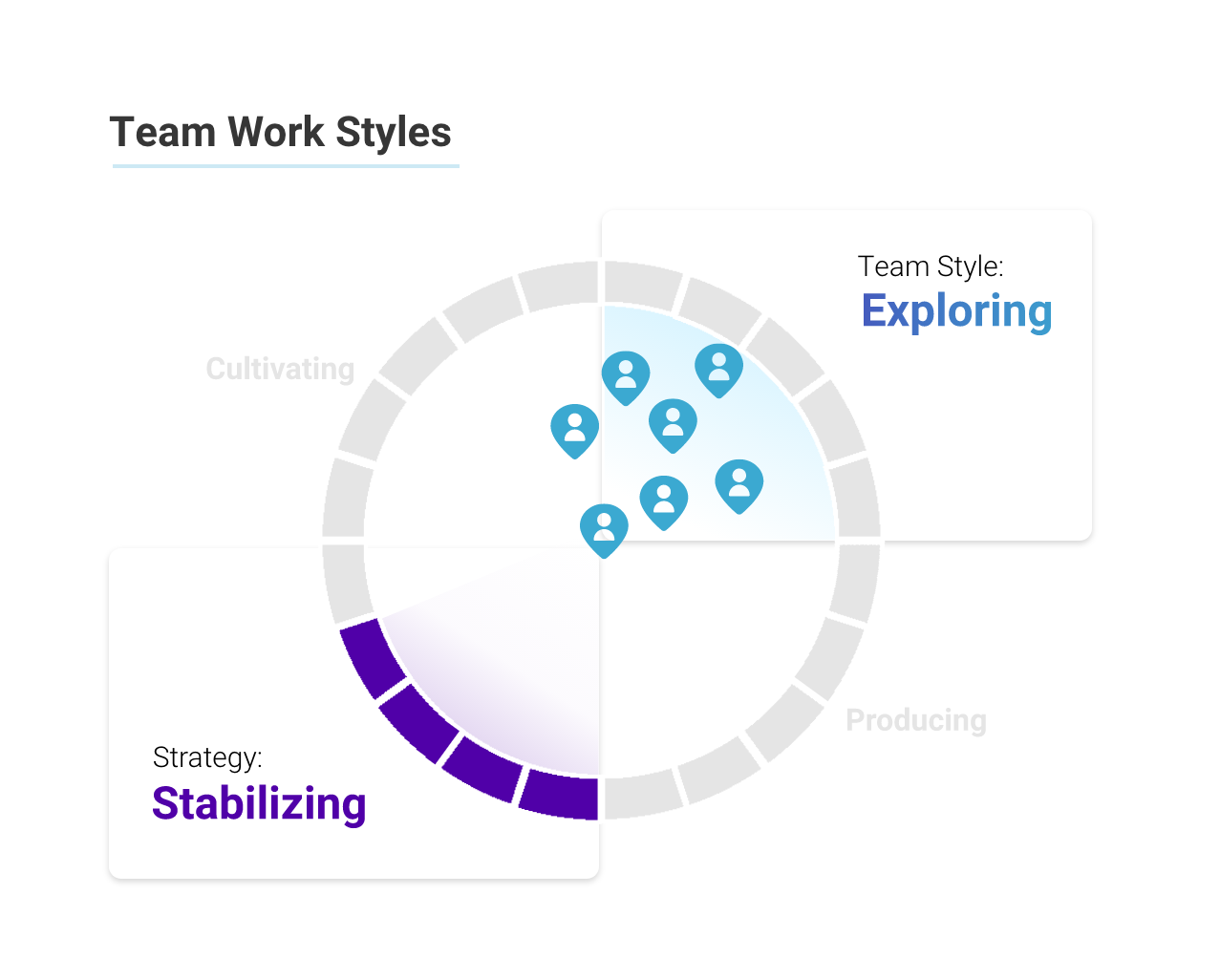What’s one thing all micromanagers have in common?
They don’t trust their people, and trust is at the core of any high-performing team.
Particularly in industries like tech, where autonomous work is essential to efficiency, micromanagement can be a morale killer. The best managers are adept at delegating work to highly engaged employees. They don’t hover, and they know that there’s a delicate balance when it comes to measuring and monitoring performance. Rather than instilling fear, they empower people, bringing out their natural leadership traits.
Of course, companies can’t expect first-time managers to know all this intuitively. And even more experienced people managers can fall into bad habits. If you want to stop micromanaging at various levels of a business, you need to be deliberate in deciding how to change organizational culture.
A personalized leadership approach for each team member.
PI’s behavioral insights help leaders inspire and coach each employee in a way they truly connect with.
Micromanagement fuels resentment and negativity—and who wants to work in an office like that? True leaders are constantly seeking to improve themselves, which means enhancing their self-awareness.
Take a close look at your management style. Do you guide your team, or try to do their work for them? How comfortable are you letting your employees complete their work on their own? Do you find it easier to do it yourself?
Review these telltale signs to determine whether you’re a micromanager. Even if you’re not, chances are, you can improve your management and communication style to better accommodate different behavioral profiles and personalities.
What is a micromanager?
Micromanagers, backseat drivers, helicopter parents… call them what you want, but none of these sound like complimentary descriptions. A micromanager is someone in a position of authority who, instead of providing clear instructions at the outset and leaving their employees to complete their tasks on their own, hovers, crowds, and deals out constant criticisms and corrections.
And the reason they’re always looking over their employees’ shoulders rings loud and clear to the employee, even if it’s unintentional: Their manager doesn’t trust them to do the job right.
While this management style could yield better-quality work in the short term, managers who consistently critique their employees’ performance without granting them any autonomy will soon foster resentment – or worse, a hostile work environment. After all, no one likes to hear that everything they do is wrong, and no one can work comfortably with someone breathing down their neck.
Micromanagement red flags: 9 signs you’re driving your direct reports crazy
Not sure what micromanagement looks like? Here are a few strong indicators you may be meddling more than you’re mentoring:
Micromanagement sign #1: You don’t allow others to make decisions.
Do you trust the people you work with to make decisions, or do you make all of the decisions for them? How much autonomy does your team have? Can they proceed with decision-making when you aren’t around?
Trust is more difficult for some than others, but it’s essential for a healthy workplace. You need to be able to trust your team, and they need to know they can trust you, too. You’ll reach fewer roadblocks, and projects will move forward more quickly when you trust others to make decisions along the way.
Micromanagement sign #2: You’d rather do it yourself than delegate.
Do you find it’s easier to do a task yourself rather than have someone else do it? Maybe you worry that if someone else takes on a task, they’ll do it differently than you. Your absence might be felt less than you think. An inability to delegate often indicates a need for control, above all else.
Are you really the only person in the world capable of doing the work that you do? Or is it possible that someone else could learn from doing? As a manager, you’re in a position to teach and guide those around you. Even if delegating may take longer at first, it will be worth it in the long run, as your team gains knowledge and learns new skills.
Micromanagement sign #3: You complain about small details.

If you’re looking for mistakes everywhere, you’re bound to find something somewhere. Wrong font? Small typo? A sentence you would write differently? Coffee made not quite the way you would do it?
Complaining all the time is bad for your well-being, and it will gradually zap your team of positive energy. Consider whether or not small annoyances are worth bringing up at all. Does it really matter what font your teammate used, or how the coffee was made?
Make a habit of taking time away from the perceived issue before saying anything about it to others. Try not to react in the moment. If the same issue comes up repeatedly, then it could be worth discussing by way of constructive feedback.
Micromanagement sign #4: You don’t take time to give constructive feedback.
Do you find yourself frequently dissatisfied with an employee’s performance? Do you find they’re still making the same mistakes? Simply telling an employee they’re not doing a good job, and then taking over that job, doesn’t really help anyone. It’s a short-term solution for you, but a barrier to your employee’s growth and development.
Constantly criticizing your employees demoralizes and demotivates them. If you’re not satisfied with someone’s performance, take the time to ask specific questions. Offering specific, constructive feedback requires emotional intelligence, tactfulness, and strong communication skills. Think about the managers, teachers, and bosses you’ve had in your own life. The ones you remember fondly are probably those who took the time to offer you guidance, and cared enough to help you expand your own personal skillset. Be that manager for your team.
Micromanagement sign #5: You don’t trust your team to work from home.

Do you trust your team to get work done when you’re not supervising every minute of their progress? Allowing employees to work remotely or from home gives them the freedom to work when and how they work best. If you find yourself wondering whether they’ll actually be productive, you likely have a larger problem on your hands.
There’s also evidence suggesting that micromanaging fully remote teams is even more damaging because it is invariably intrusive. There’s no better way to erode trust in your teams than by monitoring their every move, treating them like middle schoolers on a field trip.
Poor manager fit is one of the four forces of employee disengagement, so it’s no wonder a micromanager will often drive their people into a shell. The good news is that the habits of micromanagers aren’t unbreakable.
Jason Fried, co-author of Remote: Office Not Required, says it best: If “you can’t let your employees work from home out of fear they’ll slack off without your supervision, you’re a babysitter, not a manager. Remote work is very likely the least of your problems.”
Micromanagement sign #6: You have trouble working asynchronously.
Whether we realize it or not, we all communicate asynchronously every day. Asynchronous communication is any communication between two or more people that doesn’t require them to be in the same physical space or communicating at exactly the same time. It can include email, Slack, Google Chat, or any number of other tools customary to managing a hybrid team.
Do you feel uncomfortable or out of control if you’re not sharing the same physical space as your employees? Do you expect your team to answer your questions and get back to you the instant you reach out to them?
Communication with your employees and coworkers doesn’t need to be synchronous—meaning you don’t need to communicate instantly to get work done. Constant interruptions may actually hinder their focus and productivity. Trust others to work in the ways that best suit them, and get used to communicating asynchronously.

Micromanagement sign # 7: You don’t provide full context.
This sign may be the toughest to spot in yourself. If you often feel like your team isn’t able to complete tasks without you, or if you worry about delegating your own tasks, consider whether you’re providing your team with the full context needed to understand and work toward your (and their) goals. You may be withholding important information without even realizing you’re doing it.
Remember: You’re not an island; you’re an important part of a larger operation. You need to bring people in and provide the complete context around projects and problems, so that everyone can contribute. Even if it takes a little more time, giving your team all of the information they need is critical to maximizing their potential (and in turn, your success).
Micromanagement sign #8: You find it difficult to meet deadlines.
This is an extension of the many problems listed above—it’s a common fallout from constantly micromanaging your team. Your lack of faith in your employees means productivity hits a standstill whenever a project or piece of a project nears completion. When everything requires your seal of approval, projects get delayed, and deadlines run the risk of not being met.
You can’t be everywhere at once, and that’s precisely why you have a team behind you. A team shares responsibilities. Delegate tasks, outline clear responsibilities for different team members, and collaborate on team goals by tasking individuals their own action items. By counting on them to see those actions through, you promote trust and accountability – traits most micromanagers struggle to foster.
Micromanagement sign #9: You don’t invest in continued learning.
Do you provide opportunities for your team to learn and improve? If you don’t think your team is up to your standard now, take the time to teach them. If you don’t have the time to teach them, do your best to provide the resources or funds necessary. It’s incumbent upon you as a leader to get them the training they need to get up to snuff, however possible.
If you invest in education for your team, you’ll have more confidence in the group, and be able to let go of some responsibilities you’d otherwise save for yourself. Learning is an ongoing pursuit, and your investment in your team will illustrate that they are equally important, valued employees.
Macromanagement: Your alternative to being a micromanager

Macromanagement is just the opposite. Where micromanagers can’t keep their hands out of an employee’s work, macromanagers provide appropriate supervision, often preferring a hands-off approach that grants their team autonomy. Of course, not every person’s natural behaviors lend to this style, either. Be cognizant of individual behavioral drives, and make sure to provide extra detail and context to those who thrive on the small stuff.
Macromanagers trust their team; they delegate the responsibilities and then get out of the way—but they’re always there to offer guidance if an employee seeks it out.
The best leaders inspire their team and every individual in it. They create an environment that fosters trust and welcomes innovation, creativity, and inclusivity through their own enthusiasm, dedication, and excitement for the work. In return, they get more discretionary effort from employees.
How PI can help: Limiting employee turnover through behavioral awareness
Most people problems tie back to the four drivers of disengagement. You can’t wave a magic wand to correct a bad manager fit, but mediocre managers can improve by actively working against their micromanaging tendencies. It starts at the organizational level.
Maybe that means discovering certain people aren’t being utilized as effectively as they could be. Training managers to ask open-ended, development-oriented questions equips them with tools to help optimize the talent around them.
Companies that lean on behavioral data – a core component to the discipline of talent optimization – are in a better position to withstand losses. They have versatile team members who can wear multiple hats and stand in for their peers when needed. And they have managers who empower them to do so, playing off their strongest drives and delegating work according to their preferences and strongest tendencies.
It’s not an overnight process, by any means. Team work styles are complex, and they can shift dramatically when the headcount increases or decreases even by just one. Good managers don’t just fill holes; they recognize where gaps exist and align their teams accordingly. And they do all this while making sure everyone remembers the priorities driving the engine.
When a company makes a cultural commitment to nip micromanagement in the bud, it’s grooming leaders at every level – even if those future leaders may not know it quite yet.


